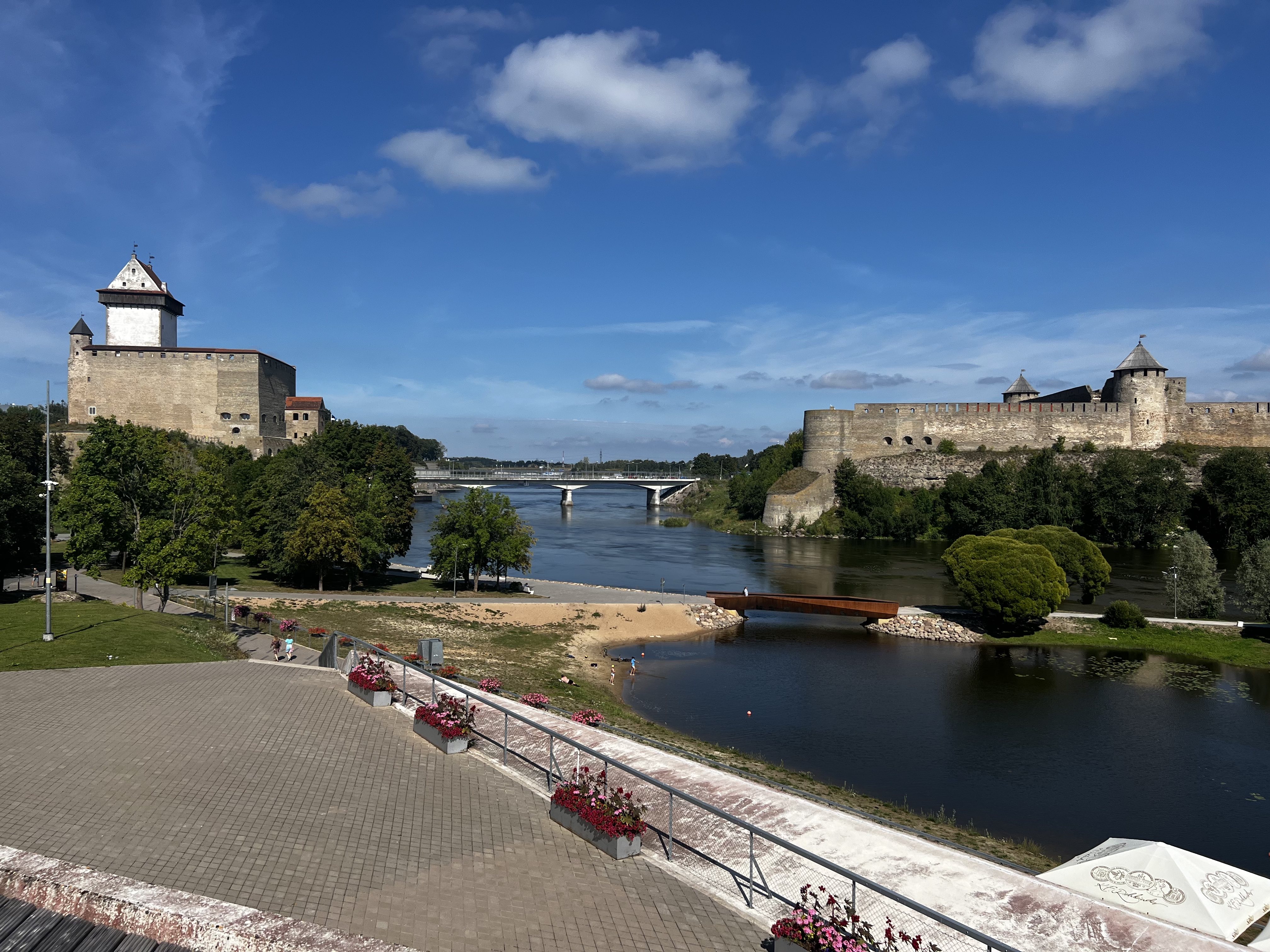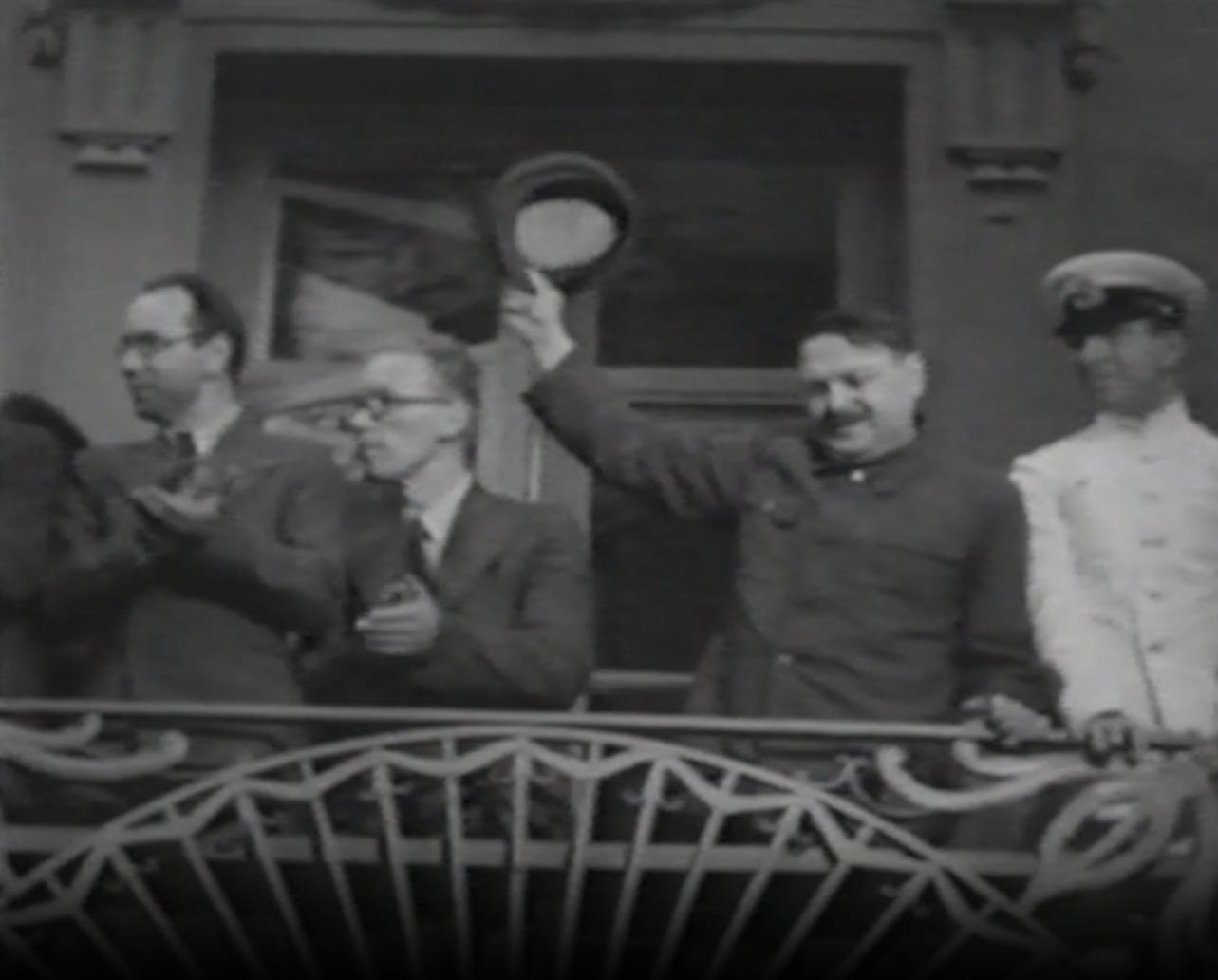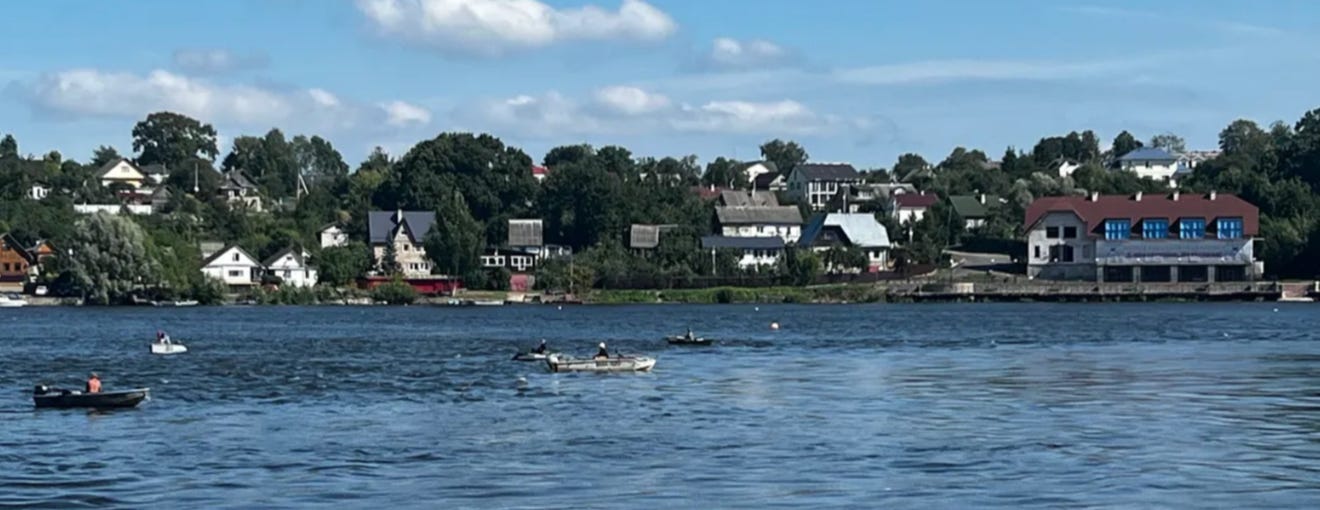Thoughts on NATO from the Estonian-Russian Border

Published by The Lawfare Institute
in Cooperation With

The old town of Tallinn, capital of Estonia, is remarkably beautiful—by far the most beautiful Northern European city I have seen.
And the Russian Federation has a predictably lovely building in the heart of the old town that serves as its embassy.

It was from the balcony of this building—the country’s former president, Toomas Hendrick Ilves, informed me this week—that Andreĭ Aleksandrovich Zhdanov, one of Stalin’s brutal henchmen, proclaimed Estonia’s joining of the Soviet Union. By this he meant its forcible annexation and the resulting decades-long obliteration of its independence. Here’s a picture I dug up of Zhdanov’s proclamation.

The iron work on the balcony hasn’t changed, but the times certainly have. Estonia is now free, a thriving member of NATO, and one of Ukraine’s most devoted supporters.
And tonight, Tallinn was the latest site of my ongoing campaign of projecting Ukrainian flags and other symbols—not all of them wholly appropriate—on Russian diplomatic facilities in democratic rule-of-law countries. As I do my best to keep these protests separate from Lawfare, I will not describe here the Tallinn event, which Ilves was good enough to host; those interested can learn more about it on here or on my various social media feeds.
I mention it only because my projection campaign yesterday took me to the small Estonian border city of Narva—and that, in turn, had me thinking about NATO.
Narva is a completely fascinating, if rather ugly, little town that sits on Estonia’s border with Russia.
It’s not Narva’s fault that it’s ugly. Blame Stalin for that.
The city was completely leveled during World War II, and when the Soviets rebuilt it, they rebuilt it with repellent Soviet mid-century architecture, which was unfortunate to look at even before it didn’t age well. The Soviets also didn’t allow the native Estonian population to return to the city, but repopulated Narva with Russians.
The result is that the town to this day is overwhelmingly Russian speaking, and some large percentage of its population retains Russian citizenship and loyalties or ambiguous citizenship—all of which makes things a little tense in a town that sits on the NATO-Russia border during a time of war in Ukraine.
When I say that Narva sits on the border, it’s important to understand just what I mean by the word “on.” I don’t mean on the border in the sense, say, that Buffalo, New York and Toronto, Ontario sit on the U.S.-Canadian border. I don’t mean that Narva is near the border—like, say, Seoul, South Korea is near the DMZ.
Unlike Sarah Palin, I am not being ridiculous when I say that I could see Russia from my hotel room. In fact, while even the best pitcher couldn’t throw a baseball into the Russian Federation from my hotel window, a good archer could certainly loose an arrow over the border from my room. And if I had fired a gun into the air in Narva, it would be as likely to kill someone in Russia as in Estonia.
Just a short (five minutes or so) walk from my hotel, in fact, was this astonishing vista. On the left of the river stands the Narva castle, which is in Estonia. Facing it on the right side of the river is the Ivangorod fortress, which is in Russia.

The border runs down the middle of the river. The bridge connecting Narva with Ivangorod is a border crossing with checkpoints on both sides of it. If you look at the photo below carefully, you can see a buoy beyond the boats from which folks on the Estonian side are fishing.

A string of those buoys is the border. The Estonian boats stay well away from the buoys.
I visited Narva because of my projection project. To wit, I was there casing the joint for a possible cross-border projection. My idea was to project from the Estonian side onto the Ivangorod fortress on the Russian side , or maybe to project onto Narva castle on the Estonian side so that the projections would be visible from Russian territory.
I was visiting Narva in an effort to determine whether I could do a projection protest there safely, and I didn’t want to give either the Russians or Russian sympathizers in Narva a heads up that it might happen.
More importantly, I wanted a chance to consult with police about whether it could be done lawfully and without creating risk of a very unfortunate incident. Meanwhile, an Estonian lawyer was discussing the matter with the Estonian authorities.
All of which had me thinking, in an uncharacteristically emotional fashion about NATO.
Without NATO, which didn’t exist when Stalin overran Estonia, Estonian independence was not sustainable. When you look at this river, and at the border running down it, that still seems true today.
It’s fashionable to hate on NATO these days—both in parts of the American and European left, where the words “American imperialism” have dogged the acronym as long as I have been alive, and on the Trumpist right, where NATO is seen as a racket by which we spend money on European security rather than on building walls.
Spend a few hours in Narva, and it’s hard not to see NATO in rather different terms—as the greatest means the world has ever devised of protecting human freedom and the right of small nations to govern themselves in a democratic fashion.
Consider this: from a hotel room in which I was surrounded by Russian nationals and could literally see Russia, I made plans very publicly to project light on the balcony from which Zhdanov erased the national independence of the country in which I am sitting.
And almost miraculously, I was able to do that without fear of Russia.
To be sure, my being able to contemplate a projection on the Russian embassy in Tallinn so close to Russia itself is a very unimportant and very minor miracle. But it is a miracle. And it’s also a very tiny part of a larger miracle that is decidedly not minor and which is almost cosmically important.
To understand this larger miracle, consider that today, the police force of this tiny rule of law country, separated from the largest country in the world by a few buoys in a river, decided whether or not to let me do my projections—both in Tallinn and in Narva.
It did this in the exercise of its own national sovereignty. And just as I could sit in Narva and write about my Tallinn without fear of Russia, it did not have to fear that its decision on this question—and on a thousand other more important matters it also addressed tomorrow—will carry the weight of risk to its continued independence.
The reason is NATO.
Consider also that there is another country that reasserted its independence after the Soviet Union’s demise. It also has borders with Russia. It also has regions in which, just like in Narva, a certain Russified minority population had retained loyalties to Russia, often concentrated in border areas. Yet this country lacked the security guarantees that come with NATO membership. And in 2014, Russia detached significant parts of its sovereign territory because of the supposed oppression of its Russian speaking population. And in 2022, Russia tried to dismember this nation entirely and obliterate its sovereign independence—much as Zhdanov did in Tallinn from that balcony onto which I projected this evening.
Now take another look at that picture of the river with the two fortresses facing one another and a bridge between them across some buoys in the water that represent an imaginary line that separates a free country from a genocidal tyranny.
And ask yourself what really protects Estonia. It’s surely not that great fiction of international law that says that smaller countries get to have independence too—the sovereign equality of states being a bit of nonsense lawyers made up. This nonsense applied to Estonia in 1940 and it applied to Ukraine both in 2014 and in 2022. And it protected nothing in either case.
Ask yourself as well how many days, weeks, or months in the absence of NATO you think it would take Vladimir Putin to send troops across that bridge and across that river because the Russian people of Narva are facing some great fictional oppression.
The countries with cities like Narva all know that it would not take long.
So how did the Estonian police handle my requests to project? It okayed the operation in Tallinn, which wrapped up about an hour ago. And the border police asked me to reconsider my Narva plans and not do a projection there.
The reason was not legality; the police did not direct me to stand down in Narva. They requested, rather, that I reconsider my plans. To be clear, the reason also wasn’t fear of provoking an international cross-border incident. The structure of deterrence is strong and stable here, thanks to Estonia’s NATO membership.
Rather, the authorities asked me not to project in Narva out of fear of what we might politely term domestic violent extremism among Russians on the Estonian side of the river. Things are tense in Narva, and the police are understandably concerned that putting a giant “Putin is a Dick” sign on Ivangorod fortress—or even putting a tasteful Ukraine flag on it—might spark violence.
Sparking violence is not my jam. And while I am all for provoking the Russians, I have no interest in creating problems for law enforcement in allied countries or exacerbating local tensions that others then have to manage.
Having spent the day yesterday in Narva, the Estonian fears seem entirely legitimate. So I have decided to honor the request and not project in Narva. Managing Russian irredentist sentiment in Narva is hard enough. I don’t want to make it harder.



.jpg?sfvrsn=5a43131e_9)

